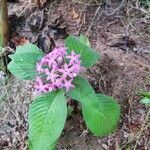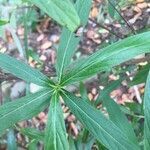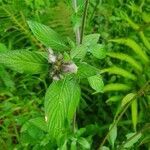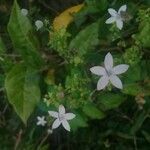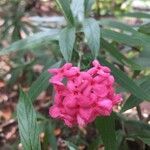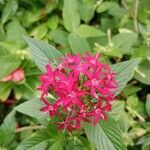Subshrubs, 30-70 cm tall; branches quadrangular, moderately to densely pilosulous to villous often becoming glabrescent with age. Leaves opposite; petiole 0.5-3 cm, pilosulous to villous; blade drying papery, oblong-lanceolate to ovate, 5-14 × 2-5.5 cm, adaxially scabrous or villous to glabrescent, abaxially densely villous or hirtellous at least along principal veins, base cuneate to obtuse, apex acute or shortly acuminate; secondary veins 8-10 pairs; stipules truncate to broadly rounded, 1.5-2 mm, villous, bristles 1-5, 1-4 mm. Inflorescence densely pilosulous to villous; peduncle 3-12 mm; branched portion congested-cymose often becoming lax, 1.5-4 × 1.5-4 cm; bracts narrowly triangular to linear, 0.5-1.5 mm. Flowers sessile or subsessile, distylous. Calyx densely hirtellous or villous; ovary portion subglobose to obovoid, ca. 1 mm; limb deeply lobed; lobes narrowly oblanceolate to elliptic or narrowly spatulate, 2-8 mm, usually unequal on an individual flower with nearly this entire size range found on some flowers, acute. Corolla pale purple to pink, red, white, or yellow, salverform, sparsely hirtellous to glabrescent outside; tube slender except rather abruptly swollen in throat in long-styled form (around stamens), 17-20 mm, densely barbate in throat; lobes elliptic or oblong-lanceolate, 3-4 mm, acute to obtuse. Capsules obovoid, 4-6 × 4-6 mm, stiffly papery to woody, with beak 1-2 mm tall; seeds 0.5-1 mm. Fl. Jul-Sep.
Long-styled flowers: corolla tube (1 )2.3–4 cm. long, dilated at the apex to 3(6) mm. wide for a distance of 4–8 mm., hairy or glabrous outside; lobes 0.3–1 cm. x (1)1.5–4.5 mm., oblong-ovate to elliptic; throat hairy within; anthers completely included; style exserted 1.5–5.5 mm.; stigma 2–5 mm. long.
Leaf blades 3–13 x 1–6 cm., ovate, lanceolate, ovate-lanceolate or elliptic, acute at the apex, cuneate at the base, pubescent to densely velvety on both surfaces; petioles 0.5 cm. long; stipules with 3–9(14) setae, 2–9 mm. long, bearing small colleters, from a short base.
Flowers with both style and stigma and anthers included; tube 2–4 cm. long; lobes 0.5–1.1 cm. x 2.5–3.3 mm., ovate-oblong; anthers sometimes with tips exserted 0.25 mm. but usually included; style and stigma always included.
Short-styled flowers very similar; corolla lobes 4.5–8 mm. long; anthers exserted 2.5–4 mm.; style and stigma usually completely enclosed or rarely tips of stigma lobes exserted 2.5 mm.
Calyx tube hairy, 1–3 x 1.5–2.5 mm. lobes very unequal, the largest 0.5–1.3 cm. x 0.5–3 mm., lanceolate, the smallest 1–3 mm. long.
Flowers often trimorphic, either with style exserted and anthers included, anthers exserted and style included or both included.
Herb or subshrub with erect or straggling mostly woody stems 0.5–1.3 m. tall, hairy.
Inflorescence with terminal and axillary components combined into a single cluster.
Fruit 4–6 mm. tall and wide, obtriangular; beak 1–2 mm. tall.

